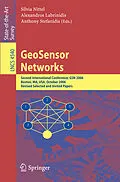This book constitutes the thoroughly refereed proceedings of the Second GeoSensor Networks Conference, held in Boston, Massachusetts, USA, in October 2006. The conference addressed issues related to the collection, management, processing, analysis, and delivery of real-time geospatial data using distributed geosensor networks. This represents an evolution of the traditional static and centralized geocomputational paradigm.
The 13 carefully reviewed and selected papers included in the volume constitute extended versions of the papers presented at the conference. They are preceded by an introduction written by the volume editors. The book is structured in sections on Data Acquisition and Processing, Data Analysis and Integration, and Applications. The papers represent key research areas that are fundamental in order to realize the full potential of the emerging geosensor network paradigm. The contributions cover theentire spectrum of the field from low-level energy consumption issues at the individual sensor level to the high-level abstraction of events and ontologies or models to recognize and monitor phenomena using geosensor networks.
Klappentext
This volume serves as the post-conference proceedings for the Second GeoSensor Networks Conference that was held in Boston, Massachusetts in October 2006. The conference addressed issues related to the collection, management, processing, ana- sis, and delivery of real-time geospatial data using distributed geosensor networks. This represents an evolution of the traditional static and centralized geocomputational paradigm, to support the collection of both temporally and spatially high-resolution, up-to-date data over a broad geographic area, and to use sensor networks as actuators in geographic space. Sensors in these environments can be static or mobile, and can be used to passively collect information about the environment or, eventually, to actively influence it. The research challenges behind this novel paradigm extend the frontiers of tra- tional GIS research further into computer science, addressing issues like data stream processing, mobile computing, location-based services, temporal-spatial queries over geosensor networks, adaptable middleware, sensor data integration and mining, au- mated updating of geospatial databases, VR modeling, and computer vision. In order to address these topics, the GSN 2006 conference brought together leading experts in these fields, and provided a three-day forum to present papers and exchange ideas.
Inhalt
to Advances in Geosensor Networks.- to Advances in Geosensor Networks.- Data Acquisition and Processing.- Impact of Drifter Deployment on the Quality of Ocean Sensing.- Efficient Data Collection and Selective Queries in Sensor Networks.- Exploiting Spatio-temporal Correlations for Data Processing in Sensor Networks.- Load Management and High Availability in the Borealis Distributed Stream Processing Engine.- Knowledge Aquisition and Data Storage in Mobile GeoSensor Networks.- Continuous Spatiotemporal Trajectory Joins.- Data Analysis and Integration.- Data-Centric Visual Sensor Networks for 3D Sensing.- A Vision for Cyberinfrastructure for Coastal Forecasting and Change Analysis.- OGC® Sensor Web Enablement: Overview and High Level Architecture.- Linking Geosensor Network Data and Ontologies to Support Transportation Modeling.- Applications.- An Operational Real-Time Ocean Sensor Network in the Gulf of Maine.- Using the Sensor Web to Detect and Monitor the Spread of Vegetation Fires in Southern Africa.- Peer-to-Peer Shared Ride Systems.
